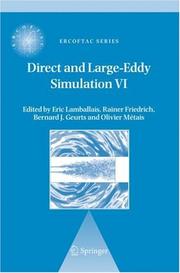| Listing 1 - 3 of 3 |
Sort by
|
Book
ISBN: 1000039726 373150197X Year: 2014 Publisher: KIT Scientific Publishing
Abstract | Keywords | Export | Availability | Bookmark
 Loading...
Loading...Choose an application
- Reference Manager
- EndNote
- RefWorks (Direct export to RefWorks)
Coherent structures are patterns in the wind field of the atmospheric boundary layer. The deployment of two scanning Doppler lidars facilitates the measurement of the horizontal wind field, but the inherent averaging processes complicate an interpretation of the results. To assess the suitability of this technique for coherent structure detection large-eddy simulations are used as a basis for virtual measurements, and the effects of the lidar technique on the wind field structure are analyzed.
Doppler-Lidar --- atmosphärische GrenzschichtDoppler-lidar --- Meteorologie --- large-eddy simulation --- meteorology --- kohärente Strukturen --- boundary layer --- coherent structures --- Grobstruktursimulation

ISBN: 9781402049095 1402049099 9786610634750 1402051522 1280634758 1429432543 9781402051524 Year: 2006 Volume: 10 Publisher: Dordrecht : Springer Netherlands : Imprint: Springer,
Abstract | Keywords | Export | Availability | Bookmark
 Loading...
Loading...Choose an application
- Reference Manager
- EndNote
- RefWorks (Direct export to RefWorks)
The sixth ERCOFTAC Workshop on ‘Direct and Large-Eddy Simulation’ (DLES-6) was held at the University of Poitiers from September 12-14, 2005. Following the tradition of previous workshops in the DLES-series, this edition has reflected the state of the art of numerical simulation of transitional and turbulent flows and provided an active forum for discussion of recent developments in simulation techniques and understanding of flow physics. At a fundamental level this workshop addressed numerous theoretical and physical aspects of transitional and turbulent flows. At an applied level it contributed to the solution of problems related to energy production, transportation and the environment. Since the prediction and analysis of fluid turbulence and transition continues to challenge engineers, mathematicians and physicists, DLES-6 covered a large range of topics, from the more technical ones like numerical methods, initial and inflow conditions, the coupling of RANS and LES zones, subgrid and wall modelling to topics with a stronger focus on flow physics such as aero-acoustics, compressible and geophysical flows, flow control, multiphase flow and turbulent combustion, to quote only a few. The present proceedings contain the written versions of 7 invited lectures and 82 selected and reviewed contributions which are organized in 16 parts entitled Turbulent Mixing and Combustion; Subgrid Modelling; Flows involving Curvature, Rotation and Swirl; Free Turbulent Flows; Multiphase Flows; Wall Models for LES; Complex Geometries and Boundary Conditions; Flow Control; Heat Transfer; Aeroacoustics; Variable Density Flows; Inflow/Initial conditions; Separated/Reattached Flows; Hybrid RANS-LES Approach; Compressible Flows; and Numerical Techniques and POD.
Fluid dynamics --- Turbulence --- Eddies --- Fluides, Dynamique des --- Tourbillons (Mécanique des fluides) --- Mathematical models --- Modèles mathématiques --- Eddies. --- Fluid dynamics. --- Turbulence. --- Engineering & Applied Sciences --- Civil & Environmental Engineering --- Civil Engineering --- Engineering - General --- Tourbillons (Mécanique des fluides) --- Modèles mathématiques --- EPUB-LIV-FT LIVINGEN SPRINGER-B --- Engineering. --- Fluid mechanics. --- Engineering Fluid Dynamics. --- Engineering, general. --- Water currents --- Whirlpools --- Hydraulic engineering. --- Construction --- Industrial arts --- Technology --- Engineering, Hydraulic --- Engineering --- Fluid mechanics --- Hydraulics --- Shore protection --- Hydromechanics --- Continuum mechanics --- Large-eddy simulation --- Direct simulation
Book
ISBN: 3039211099 3039211080 Year: 2019 Publisher: MDPI - Multidisciplinary Digital Publishing Institute
Abstract | Keywords | Export | Availability | Bookmark
 Loading...
Loading...Choose an application
- Reference Manager
- EndNote
- RefWorks (Direct export to RefWorks)
There is overwhelming evidence, from laboratory experiments, observations, and computational studies, that coherent structures can cause intermittent transport, dramatically enhancing transport. A proper description of this intermittent phenomenon, however, is extremely difficult, requiring a new non-perturbative theory, such as statistical description. Furthermore, multi-scale interactions are responsible for inevitably complex dynamics in strongly non-equilibrium systems, a proper understanding of which remains a main challenge in classical physics. As a remarkable consequence of multi-scale interaction, a quasi-equilibrium state (the so-called self-organisation) can however be maintained. This special issue aims to present different theories of statistical mechanics to understand this challenging multiscale problem in turbulence. The 14 contributions to this Special issue focus on the various aspects of intermittency, coherent structures, self-organisation, bifurcation and nonlocality. Given the ubiquity of turbulence, the contributions cover a broad range of systems covering laboratory fluids (channel flow, the Von Kármán flow), plasmas (magnetic fusion), laser cavity, wind turbine, air flow around a high-speed train, solar wind and industrial application.
non-locality --- hybrid (U)RANS-LES --- channel flow --- thermodynamics --- Lévy noise --- non-local theory --- low speed streaks --- drop breakage --- pipe flow boundary layer --- bifurcation --- Langevin equation --- attached and separated flows --- anomalous diffusion --- kinetic theory --- stochastic processes --- self-organisation --- spatiotemporal chaos --- chaos --- bifurcations --- turbulent flow --- Lyapunov theory --- Rushton turbine --- turbulence --- intermittency --- information length --- denoise --- microcavity laser --- free vortex wake --- IDDES methodology --- local intermittency --- control strategy --- population balance equation --- Tsallis entropy --- coherent structures --- Fokker-Planck equation --- energy cascade --- fluid dynamics --- high efficiency impeller --- fractals --- large eddy simulation --- shear flows --- heat transport --- multifractal --- drop coalescence --- continuous wavelet transform --- T-junction --- scaling properties --- floating wind turbine --- scaling --- fractional Fokker–Plank equation --- magnetic confinement fusion --- multi-scale problem --- coherent structure --- solar wind --- trailing-edge flap --- turbulent transition --- turbulent boundary layer --- complex dynamics --- statistical mechanics
| Listing 1 - 3 of 3 |
Sort by
|

 Search
Search Feedback
Feedback About
About Help
Help News
News